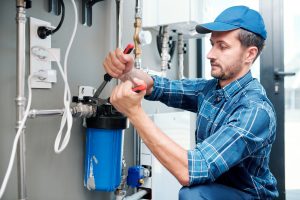Everything You Need To Know Before Installing A Home Water System
 Installing a water system in your home can be a daunting task. It’s important to ensure that you have the right equipment and materials, and that the installation process is done correctly. This can be a challenging task, especially if you don’t have any experience. Fortunately, with the right guidance and resources, you can make sure that you get it done safely and effectively. In this article, we’ll cover everything you need to know before installing a home water system. From determining what type of system you need, to choosing the right materials and equipment, we’ll make sure you’re equipped with the information and tools you need to get the job done.
Installing a water system in your home can be a daunting task. It’s important to ensure that you have the right equipment and materials, and that the installation process is done correctly. This can be a challenging task, especially if you don’t have any experience. Fortunately, with the right guidance and resources, you can make sure that you get it done safely and effectively. In this article, we’ll cover everything you need to know before installing a home water system. From determining what type of system you need, to choosing the right materials and equipment, we’ll make sure you’re equipped with the information and tools you need to get the job done.
Types of home water systems
There are three main types of water systems that can be installed in your home: – Gravity Systems- These systems are usually found in smaller homes, cabins, and other small structures. Gravity systems work by pumping water from a lower water source, like a well, up to the higher elevation of your house. – Pressurized Systems- These systems are found in most larger buildings, including commercial buildings and apartment complexes. This type of system pumps water from a lower water source and pumps it directly into your home. – Hybrid Systems- These systems are a combination of the above two systems. They usually pump water from a lower water source, but then send it to the upper part of your house through gravity.
Benefits of installing a home water system
There are a lot of benefits to installing a home water system, like increased safety and convenience. Water systems are installed by a professional, so this makes it easier for you to have the system operational. And if you have a water issue, like low water pressure, you can get it solved right away since it won’t be a do-it-yourself project. Water systems are also a good investment because they can help increase the value of your home.
Preparing for the installation
– Location – The location of the water source must be known before installation. The water source is the place where the water is pumped from. It is important to know the location of the water source because the distance between the water source and the water tank must be known so that the correct water pump can be selected. – Space – Make sure you have enough space for the water system and its components. For example, a water tank must be above the water source to be gravity fed. If you don’t have enough space, you can look into installing a pressurized water system. – Code Requirements – Make sure you check local and state building codes to see if you need a water permit. If you are installing a pressurized water system, you must have a permit.
Choosing the right materials and equipment
– Water Source – The water source is the location where the water is pumped from. There are a few water source options, like wells and surface water locations. But make sure that the water source you choose is in an approved location. – Water Storage – The water storage tank is the container that holds water. It also helps regulate pressure and water flow throughout the house. There are a few different types of water storage containers to choose from, like steel or plastic. One important thing to consider when selecting a water storage tank is the size. It’s important to select a water tank that can hold the amount of water needed for your home. – Water Pump – The water pump is what sends the water from the water source to the water tank and then to the rest of your house. There are two types of pumps: submersible and non-submersible. Submersible pumps are designed to be below the water line and non-submersible pumps are designed to work above the water line. – Water Flow Regulator – The water flow regulator is a device that enables you to control the flow of water. It helps prevent water waste when there is low pressure in the water system. You can choose from a manual or electronic regulator depending on your needs.
Understanding water pressure and flow
– Flow – Flow is the rate at which water comes out of your faucets. The most common flow rate is 2 gallons per minute (GPM) per faucet. Flow is measured in gallons per minute (GPM). – Pressure – Pressure is the amount of force behind the water flow. The normal water pressure in the US is between 30 and 60 PSI.
Steps to installing a home water system
– Selecting The Water System Type – The first step in installing a home water system is to select the type of water system you will install. – Selecting A Water Source – Next, you need to select the water source. The water source is the location where the water will be pumped from. – Locating The Water Storage Tank – After that, you need to locate the water storage tank. The water storage tank holds water and helps regulate pressure and water flow throughout the house. – Selecting The Water Flow Regulator – The water flow regulator is a device that enables you to control the flow of water. – Selecting A Water Pump – After selecting the water flow regulator, you need to select a water pump. The water pump is what sends the water from the water source to the water tank and then to the rest of your house. – Selecting The Water Pipe Material – The next step is to select the water pipe material. There are two types of materials that are commonly used for water pipe: copper and polyethylene. – Selecting The Water Filter Type – The next step is to select the water filter type. There are two types of water filters that you can use: a sediment filter and a carbon filter. – Selecting The Water Pressure regulator – The next step is to select the water pressure regulator. The water pressure regulator is a device that is used to control water pressure in the water system. – Selecting The Water Faucet Type – The last step is to select the water faucet type. The water faucet type determines the type of faucet that is installed in the house.
Troubleshooting and maintenance tips
– Low Water Pressure – If you experience low water pressure, there are a few things that you can do to troubleshoot the issue. Start by shutting off the water system and then turning it back on. If the pressure does not increase, check the water pressure regulator. If you find a problem with the regulator, you can replace it. – Low Water Flow – If you notice that the flow of water is low, check the water filter and the water pressure regulator. Make sure that the water filter is clean and if it is not, clean it. If the water flow is still low after you clean the water filter, check the water pressure regulator. If the water flow is low after checking both the water filter and the water pressure regulator, check the water source. – High Water Pressure – If you experience high water pressure, there are a few things that you can do to troubleshoot the issue. Start by shutting off the water system and then turning it back on. If the pressure does not decrease, check the water pressure regulator. If the pressure is still high, check the water source. – High Water Flow – If you notice that the flow of water is high, check the water filter and the water pressure regulator. Make sure that the water filter is clean and if it is not, clean it. If the water flow is still high after you clean the water filter, check the water pressure regulator. If the water flow is still high after checking both the water filter and the water pressure regulator, check the water source.
Professional installation services
If you don’t think that you have the time or the expertise to install the system yourself, you can hire a company to do it for you. A reputable company will come to your home, assess the situation and provide you with a free estimate. If you decide to hire them, they will install the water system for you.
FAQs about home water systems
– What is a water softener? A water softener is a device that removes minerals from water, like calcium and magnesium. When these minerals build up in water pipes, they can cause clogs and leaks. – What is a water filtration system? A water filtration system is a device that removes particles and contaminants from water. A filtration system can help improve the taste of water and can improve health. – What is a water
